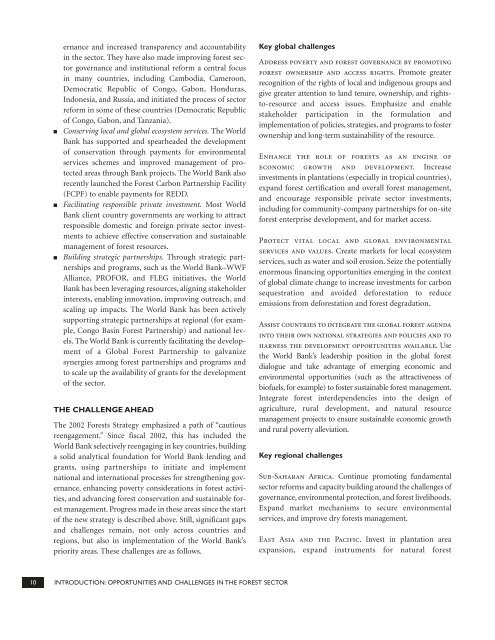Forests Sourcebook - HCV Resource Network
Forests Sourcebook - HCV Resource Network
Forests Sourcebook - HCV Resource Network
Create successful ePaper yourself
Turn your PDF publications into a flip-book with our unique Google optimized e-Paper software.
■<br />
■<br />
■<br />
ernance and increased transparency and accountability<br />
in the sector. They have also made improving forest sector<br />
governance and institutional reform a central focus<br />
in many countries, including Cambodia, Cameroon,<br />
Democratic Republic of Congo, Gabon, Honduras,<br />
Indonesia, and Russia, and initiated the process of sector<br />
reform in some of these countries (Democratic Republic<br />
of Congo, Gabon, and Tanzania).<br />
Conserving local and global ecosystem services. The World<br />
Bank has supported and spearheaded the development<br />
of conservation through payments for environmental<br />
services schemes and improved management of protected<br />
areas through Bank projects. The World Bank also<br />
recently launched the Forest Carbon Partnership Facility<br />
(FCPF) to enable payments for REDD.<br />
Facilitating responsible private investment. Most World<br />
Bank client country governments are working to attract<br />
responsible domestic and foreign private sector investments<br />
to achieve effective conservation and sustainable<br />
management of forest resources.<br />
Building strategic partnerships. Through strategic partnerships<br />
and programs, such as the World Bank–WWF<br />
Alliance, PROFOR, and FLEG initiatives, the World<br />
Bank has been leveraging resources, aligning stakeholder<br />
interests, enabling innovation, improving outreach, and<br />
scaling up impacts. The World Bank has been actively<br />
supporting strategic partnerships at regional (for example,<br />
Congo Basin Forest Partnership) and national levels.<br />
The World Bank is currently facilitating the development<br />
of a Global Forest Partnership to galvanize<br />
synergies among forest partnerships and programs and<br />
to scale up the availability of grants for the development<br />
of the sector.<br />
THE CHALLENGE AHEAD<br />
The 2002 <strong>Forests</strong> Strategy emphasized a path of “cautious<br />
reengagement.” Since fiscal 2002, this has included the<br />
World Bank selectively reengaging in key countries, building<br />
a solid analytical foundation for World Bank lending and<br />
grants, using partnerships to initiate and implement<br />
national and international processes for strengthening governance,<br />
enhancing poverty considerations in forest activities,<br />
and advancing forest conservation and sustainable forest<br />
management. Progress made in these areas since the start<br />
of the new strategy is described above. Still, significant gaps<br />
and challenges remain, not only across countries and<br />
regions, but also in implementation of the World Bank’s<br />
priority areas. These challenges are as follows.<br />
Key global challenges<br />
Address poverty and forest governance by promoting<br />
forest ownership and access rights. Promote greater<br />
recognition of the rights of local and indigenous groups and<br />
give greater attention to land tenure, ownership, and rightsto-resource<br />
and access issues. Emphasize and enable<br />
stakeholder participation in the formulation and<br />
implementation of policies, strategies, and programs to foster<br />
ownership and long-term sustainability of the resource.<br />
Enhance the role of forests as an engine of<br />
economic growth and development. Increase<br />
investments in plantations (especially in tropical countries),<br />
expand forest certification and overall forest management,<br />
and encourage responsible private sector investments,<br />
including for community-company partnerships for on-site<br />
forest enterprise development, and for market access.<br />
Protect vital local and global environmental<br />
services and values. Create markets for local ecosystem<br />
services, such as water and soil erosion. Seize the potentially<br />
enormous financing opportunities emerging in the context<br />
of global climate change to increase investments for carbon<br />
sequestration and avoided deforestation to reduce<br />
emissions from deforestation and forest degradation.<br />
Assist countries to integrate the global forest agenda<br />
into their own national strategies and policies and to<br />
harness the development opportunities available. Use<br />
the World Bank’s leadership position in the global forest<br />
dialogue and take advantage of emerging economic and<br />
environmental opportunities (such as the attractiveness of<br />
biofuels, for example) to foster sustainable forest management.<br />
Integrate forest interdependencies into the design of<br />
agriculture, rural development, and natural resource<br />
management projects to ensure sustainable economic growth<br />
and rural poverty alleviation.<br />
Key regional challenges<br />
Sub-Saharan Africa. Continue promoting fundamental<br />
sector reforms and capacity building around the challenges of<br />
governance, environmental protection, and forest livelihoods.<br />
Expand market mechanisms to secure environmental<br />
services, and improve dry forests management.<br />
East Asia and the Pacific. Invest in plantation area<br />
expansion, expand instruments for natural forest<br />
10 INTRODUCTION: OPPORTUNITIES AND CHALLENGES IN THE FOREST SECTOR

















